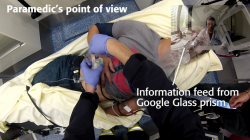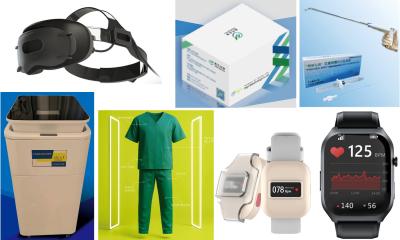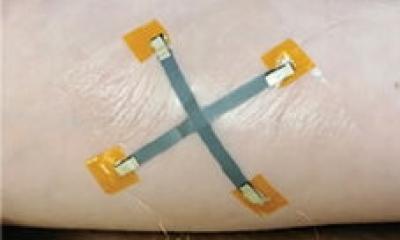Technology
Wearable sensors
Wrist-watches, wrist and arm bands, tags, finger rings, clips, smart glasses, shoes, insoles, smart patches (as thermometers), sensors woven into fabrics for T-shirts and socks and, of course, implantable devices as well as ingested pills were displayed by 23 exhibitors in the Wearable Technologies Show at Medica this year.
Report: Cornelia Wels-Maug

Among physiological, biochemical and motion sensing technologies there was even an entire laboratory solution for home monitoring, with Fraunhofer Institute of Technology demonstrating how patient tracking can be implemented. This platform, developed and tested by researchers at Fraunhofer FIT, with the Berlin-based Charité hospital, T-Systems and other international partners, uses non-invasive sensors and other technology to sample blood and determine specific markers in blood, aiming to monitor cardiac diseases among the elderly at home.
Wearable sensors to measure vital parameters can be connected to this platform, which collects the various sensors’ data for internet transmission to a patient’s caregiver for analysis. Should the data exceed or fall short of a particular threshold, caregivers can intervene if necessary. Using an app on his/her smartphone, the patient can read the measurements along with the clinician’s instructions.
Yes, given diminishing healthcare resources, the prospect of caregiving becoming more effective due to mobile sensors looks promising; yet their use − although much hyped by the ‘quantified self’ movement − is far from a familiar feature in healthcare institutions. ‘I’m still critical about the use of wearable sensors in healthcare, because the regular incorporation of sensor data into a clinical information system is not straightforward,’ cautions Markus Stein, Head of Patient Management at Ethianum, an almost fully digital clinic in Heidelberg. ‘The development of interfaces is complex and therefore expensive.
‘This is further complicated because there is no data standard for vendors of mobile sensors and service providers. As a result there are only proprietary interfaces that must be tailored to each healthcare provider, leading invariably to a cost explosion,’ he adds. In addition, there is the inherent risk that a battery-powered wearable sensor runs out of energy while monitoring a patient.
Are there any real uses of wearable sensors in medical care? Stein: ‘The use of digestible pills is probably an interesting case for wearable sensors; they are already used to gain insights into the gastro-intestinal tract.’ Other than this, there appear to be very few current uses.
Researchers from the medical information sciences division at the University Hospitals of Geneva, Switzerland, work on wearable sensors to monitor chronically ill patients. Team member Frederic Ehrler PhD: ‘Ageing and chronic diseases drive up healthcare costs. Self-monitoring might be an avenue to decrease the pressure on health professionals, but we need to merge the different sensors into an aggregated physiological sensors network to consolidate all gathered data to improve care.
‘In our project we use an Arduino platform, to which we connect ten different mobile sensors. This gives us a good starting point to identify problems associated with the integration of multiple sensors. Lots of work went into solving the technical problems and now we concentrate on developing solutions for specific diseases. For this, we involve many stakeholders in the process to respond best to users’ needs.’
Antoine Widmer, University of Applied Sciences Western Switzerland, Sierre, explains how the university is working with paramedics in Fribourg to develop an app which, combined with Google Glasses, enhances pre-hospital care by speeding up diagnosis. ‘Because every minute counts, we presently test Google Glasses with paramedics who can collaborate in real-time with clinicians in the hospital. Via the built-in camera the physician can see and hear what a paramedic witnesses and can give precise medical guidance – on mediation, for example. Another plus is that this solution allows physicians to remain in hospital where they are needed most, but they can help multiple paramedic crews. This saves time and resources.’ Are there glitches in the system? Widmer: ‘The hardware needs improvement: battery life is not yet sufficient, nor is the internet connection stability.’
Paul Doherty, Vice-President of Sales at Shimmer, stressed in his Medica presentation: ‘Wearable technology will be one of the most important decision support systems in the future of healthcare.’ However, before this can happen, industry standards must be defined to curb integration costs; viable business models are needed and a secure, smooth aggregation of diverse data sources needs to be in place. It will still take considerable time before wearable sensors become part of mainstream healthcare provision.
18.12.2014











